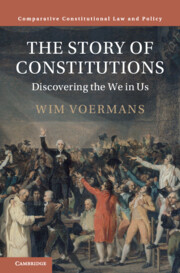Book contents
- The Story of Constitutions
- Comparative Constitutional Law and Policy
- The Story of Constitutions
- Copyright page
- Dedication
- Epigraph
- Contents
- Figures
- Prologue
- 1 Introduction
- Part I Constitutional Diffusion
- Part II The History of the Constitution
- 4 Precursors
- 5 Etched into Collective Memory
- 6 Roman Roots
- 7 Mediaeval Constitutions
- 8 Early-Modern Constitutions
- 9 Generations
- 10 Second Generation
- 11 Third Generation
- 12 Fourth Generation
- 13 Fifth Generation
- 14 Sixth Generation
- 15 The Seventh Generation
- 16 The Eighth Generation
- 17 What Are the Lessons of History?
- Part III Concepts, Shapes and Types of Constitutions
- Part IV Effects
- Part V The Imagined Order of the Constitution
- References
- Name & Author Index
- Subject Index
15 - The Seventh Generation
Liberation Constitutions
from Part II - The History of the Constitution
Published online by Cambridge University Press: 19 October 2023
- The Story of Constitutions
- Comparative Constitutional Law and Policy
- The Story of Constitutions
- Copyright page
- Dedication
- Epigraph
- Contents
- Figures
- Prologue
- 1 Introduction
- Part I Constitutional Diffusion
- Part II The History of the Constitution
- 4 Precursors
- 5 Etched into Collective Memory
- 6 Roman Roots
- 7 Mediaeval Constitutions
- 8 Early-Modern Constitutions
- 9 Generations
- 10 Second Generation
- 11 Third Generation
- 12 Fourth Generation
- 13 Fifth Generation
- 14 Sixth Generation
- 15 The Seventh Generation
- 16 The Eighth Generation
- 17 What Are the Lessons of History?
- Part III Concepts, Shapes and Types of Constitutions
- Part IV Effects
- Part V The Imagined Order of the Constitution
- References
- Name & Author Index
- Subject Index
Summary
The atrocities of World War II make the world realise how vulnerable national constitutional arrangements are. To effectively protect civil rights and liberties, to avoid gross injustices (genocide, discrimination, etc.), and to ensure peace, international cooperation on a global scale is needed. With new international institutions and mechanisms (the United Nations, The Universal Declaration of Human Rights, Human rights treaties, the UN Security Council) the united nations of the world centre on the protection, freedom and welfare of individual human beings regardless where they are or in whatever system they might live. Constitutions everywhere in the world begin express the universal principles of individual autonomy, inalienable human rights, freedoms and the right to self-determination. The implementation of the latter principle heralds in the era of decolonialization. Autocratic systems (classic dictatorships) are pressured under the new universal principles by the international community to set their people free. The new generation of liberation constitutions centre on universal values, with a special focus on self-determination. In the various (new) communist systems that come up this boils down to the right of the workers to determine a socialist (non-capitalist) future with fair labour ship and property relations.
Keywords
- Type
- Chapter
- Information
- The Story of ConstitutionsDiscovering the We in Us, pp. 169 - 179Publisher: Cambridge University PressPrint publication year: 2023

